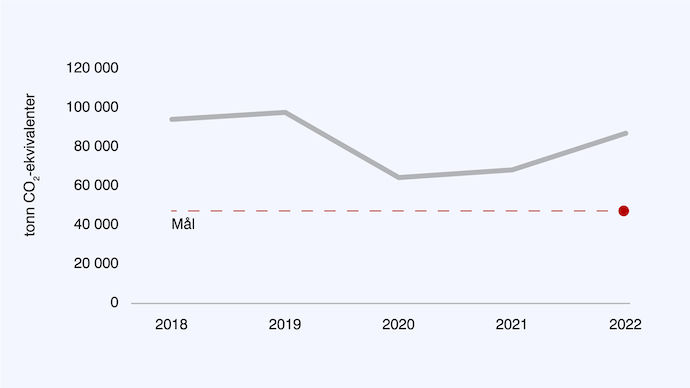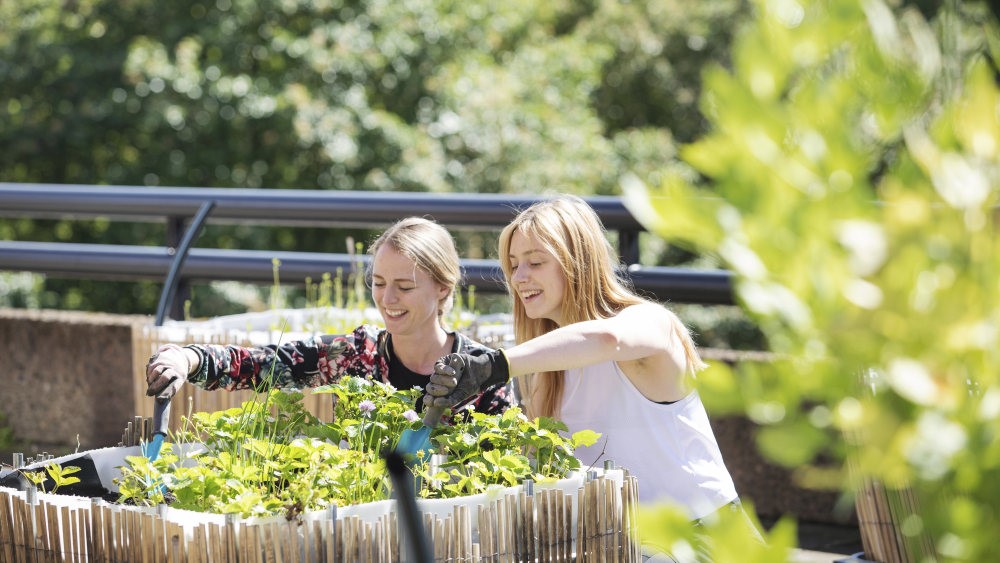Yearly climate accounts are vital to keep us on track to reaching our goals and to see if we are implementing the right measures. The categories with the highest emissions are the procurement of goods, travel, buildings and energy consumption. In the categories of energy consumption, procurement of services, waste, and travel emissions were reduced, whereas in the procurement of goods and building categories emissions went up in 2022.
Keep the pressure on
The largest increase in emissions is in the category buildings, where the emissions have increased by 58 percent in 2022 in comparison to 2018, our year of reference. The main reason for this increase is due to larger renovation projects in Eilert Sundts hus and Br?ggers hus. These renovations are the most extensive in the history of UiO history, and no similar projects are planned the upcoming years.
Overall, UiO has reduced emissions by eight percent between 2018 and 2022.
– I am glad emissions are decreasing, and that both emissions from travel and energy consumption are down. Working systematically over time with effective energy use has given results. What is important moving forward is that we keep the pressure on the areas where we can further reduce our emissions, says Mette Halskov Hansen, Vice-Rector for Climate & the Environment and Cross-Disciplinarity.
She points out that the climate accounts show that the emissions are not decreasing fast enough at the moment in order for UiO to reach its goal of cutting emissions in half by 2030.
– We cannot sit back and expect that the emissions will be cut in half on their own, says Hansen.
These goals are laid out in UiO's Comprehensive Climate and Environment Strategy, whereas the action plan is revised yearly.
Useful tool
Hansen believes that the climate accounts are a useful tool to measure how the work is going, despite methodological weaknesses.
– We have spent a lot of time putting together the climate accounts for 2021 and 2022 because there are methodological challenges connected to comparing datasets between years. The goal now is to monitor the progress. It is important to show that a research-intensive university is capable of conducting high-quality research and education on an international level, while still reducing its greenhouse gas emissions.?
Hansen points out that the climate accounts only reflect a portion of UiO's work.
– Our most crucial contribution to battling the climate and nature crisis is research and educating students with competence in climate change, environment and sustainability, she says.?
Read more about UiO’s work on climate change, the environment and sustainability

Less traveling by plane
The good news in last year's numbers is that emissions from air travel have been significantly reduced in comparison to numbers from before the pandemic. UiO's goal is to halve greenhouse gas emissions from work-related traveling between 2018 and 2030. This includes all travel by our employees to and from conferences, fieldwork and other international research and teaching collaborations.
Travel as a whole was responsible for 18 percent of greenhouse gas emissions in 2022 at UiO. This does not include traveling to and from campus. Air travel makes up 92 percent of this category.
To get a more precise image of the emissions related to air travel, UiO has adjusted the 2018 numbers. This is because the data from 2018 did not include any flights booked outside of UiO’s travel portal.
– Our numbers show that emissions from air travel are reduced by 33 percent from 2018 to 2022. The goal is to halve the emissions by 2030. This means that we are on track to reach the goal if we continue at the same pace over the next few years. There is no doubt that people have become much better at considering whether or not travelling by plane is necessary, and in addition, we have become more accustomed to digital tools for meetings and conferences. Thank you to everyone who contributes, says Hansen.
She argues that it is important to keep working on climate reducing measures. This autumn UiO is launching new guidelines for travel.
– We will make it easier to take more climate friendly choices when traveling, and we will look into stricter requirements regarding the assessment of which travels are necessary and for whom, says Hansen.
Energy and waste
Another goal is to reduce energy consumption by 30 percent between 2018 and 2030. We are on track to reach this goal, largely due to measures to use energy in our buildings more efficiently. In 2022 energy consumption was down 21 percent compared to 2018.
Emissions from waste are down 17 percent, even though the amount of waste has increased in weight. The reduction is due to the recycling of all plastic, which reduced the emissions by 85 percent.
How the climate accounts are made
About the methodology
The UiO climate accounts are made with the help of Klimakost, a tool made to measure greenhouse gas emissions for organisations. The goal is to give an overview of what areas contribute most to our climate footprint?- and thus be able to measure the progress towards the goals we have set.
The methodology utilises calculations of accounting data multiplied by emissions factors, which are indirect emissions rather than measured direct emissions. This methodology is the same as is used when the Norwegian Environment Agency makes Norway's National Greenhouse Accounts in accordance with the guidelines from the UN Intergovernmental Panel on Climate Change.?Klimakost is also used by the City of Oslo and other universities.
Klimakost is still under development, but it is the best-developed tool we have access to at the moment in the higher education sector in Norway. We work continuously to gather and provide better data about emissions at UiO in order to create a clear picture of our total emissions. For instance, we want to gather data related to larger procurements of goods, rather than basing the data solely on economic emission factors.
About air travel
Due to the methodological changes in the Klimakost reporting, the data on emissions related to air travel are not directly comparable to the data from 2022. In addition to the report, UiO has done its own estimates regarding the air travel emissions from 2018.
In 2022 35 percent of work-related travel was ordered outside the UiO travel portal. Hence, the 2018 numbers were adjusted accordingly. The total emissions from air travel in 2018 is estimated to be 21 470 tonnes of CO2-equivalents. In 2022 the total number was 14 334, which is a reduction by 33 percent.?
